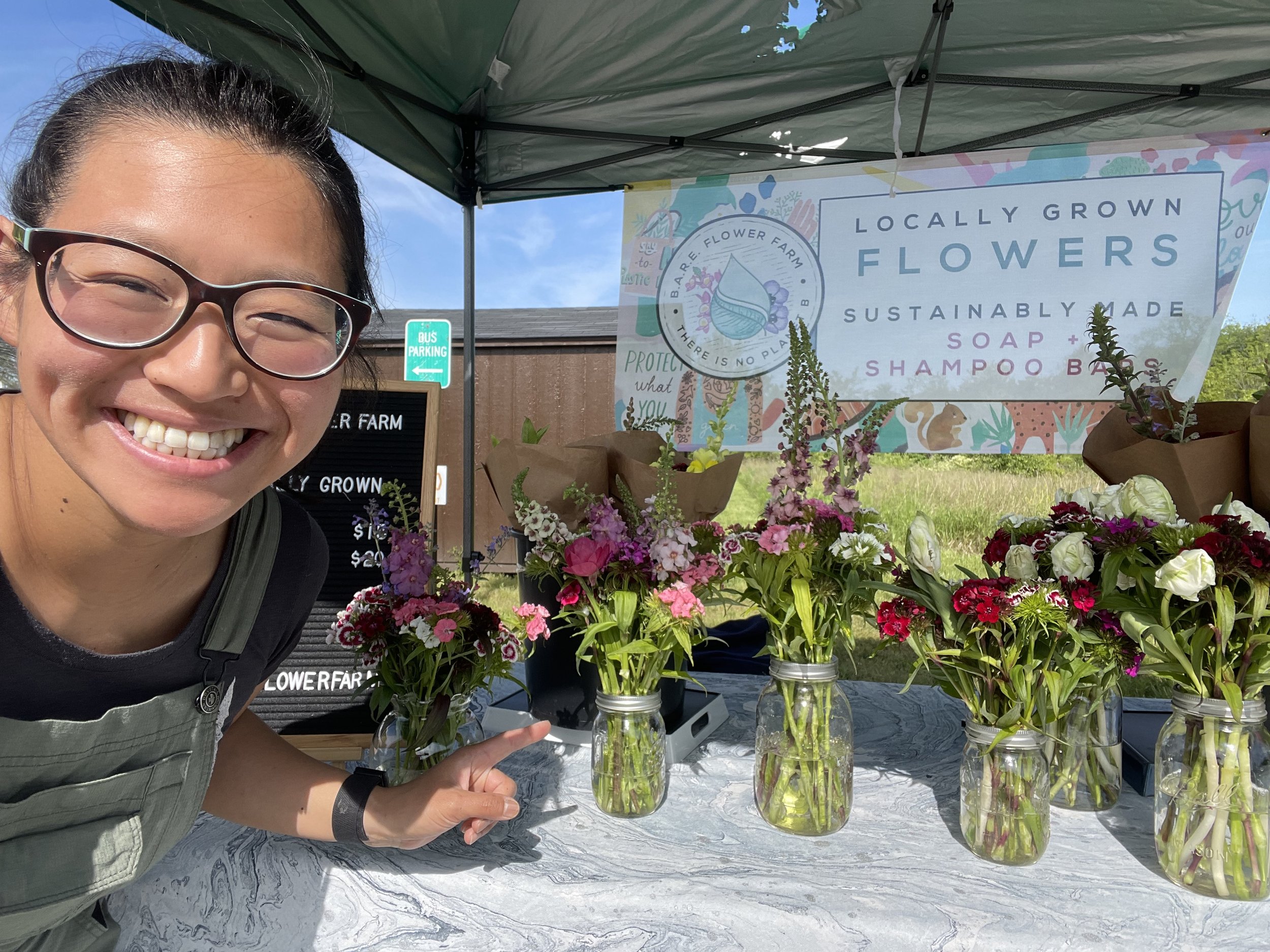Why You NEED to Be Overwintering
When I first started flower farming, I knew automatically I wanted to focus on the shoulder seasons, especially early Spring, to sell my flowers. As someone with a relatively demanding full time job, who wants to farm in the hot, humid weather of NJ? There’s a ton of pest pressure and a lot of others growing flowers at the same time. Add on top the fact I knew I was expecting, overwintering became a no brainer.
Why overwinter?
Achieve the earliest blooms possible! The plants are established and once the warmer weather comes, they will take off. Note that spring flower sales are typically the strongest. It is hard to achieve blooms by Mother’s Day in the northern US, but overwintering allows you to do so without a structure!
When overwintered properly, the plants can be healthier, more robust, and generate taller stems. This isn’t always the case especially if you’re overwintering a variety that can’t tolerate the lowest temps in your environment (Snapdragons are an example for me)
You don’t need to transplant during the early spring when the weather fluctuates in a way that can weaken or kill your cool hardy seedlings. There’s the added bonus of not needing to prepare the area or get out in the wet, cold weather that time of year!
Considerations:
Seasoned flower farmers will overwinter as a means to generate the earliest blooms. If you’re a small scale farmer like me and don’t have any formal growing structures (greenhouse or hoophouse), you can likely still overwinter, especially if you live in zones 4-7. Someone living in zone 4 will have fewer varieties to overwinter vs someone in zone 7 but there is still plenty you can overwinter.
Some varieties are better overwintered in something like a caterpillar tunnel or at least covered. I constructed hoops from irrigation piping and connected them to rebar. Then, I secured the top using long tomato stakes as a
”skeleton”. Finally, I put AG-19 cover over them. We had a very rare winter with no snow. Of course, I couldn’t predict no snow so this worked out well but I would expect this setup to not be able to hold up to significant snow load. See Youtube video above for details.
Challenges:
The challenge with overwintering for the beginner or very small grower is that you have to be on top of it. Not only do you need to remember WHEN to do it, the “when” happens at one of the busiest times of year as you’re harvesting and potentially succession planting for the fall. As someone who does not at all enjoy the process of starting from seeds and nurturing plants (I am notorious for forgetting to water my seedlings in the winter, could you imagine me trying to remember with everything else going on in the summer?), I outsourced it!
Cost of seedlings:
My local grower friend absolutely loves this nurturing process so I worked with her to determine what I should grow and outsourced all of the growing labor to her. I am very lucky to have this option. Her growing values are closely aligned with mine and I trust how she’s growing everything. From a cost perspective, we took how much we could procure similar plugs for from someone like Farmer Bailey and added a 20% markup since she was growing them organically and didn’t have the economies of scale. The total came out to $475 for just over 1000 seedlings. Some varieties like snapdragons were cheaper ($0.23 / seedling) vs something like sea holly ($0.64 / seedling) which was the most expensive. We were both super happy - she made enough money to buy seeds for the 2023 season and I didn’t have to worry about my 2023 spring.
If you don’t have someone who could grow seedlings for you, I suggest you look for a plug supplier. There are many out there. Farmer Baileys and Kube-pak are just a couple of more well known suppliers. There are typically local and regional options if you ask around. One thing to note about the bigger guys- they are typically growing in greenhouses which means that they are likely going to have to spray in order to keep disease and pests in check. They are also likely using alot of peat if that is something that matters to you. While my local grower does use peat, she is also using organic compost and worm castings, which I think ultimately does make a difference post transplant. More importantly, I can pick up from her which means there is minimal chance of the seedlings getting damaged in transit and a generally smaller carbon footprint.
What did I overwinter?
I live in central west New Jersey (Zone 6b), just 25 minutes away from the PA border. Our winters can get cold, but alot is still able to overwinter. Of the list below, only the snaps needed to be covered, though my uncovered snaps eventually did send up blooms, just a bit later (just a couple of weeks ahead of Group 1 flowering snaps that were started in January 2023).
Of everything on this list, I had ever only grown snapdragons and rudbeckia. My growing career is short and we moved to this property in mid March 2022, which meant I missed out on the spring varieties. But that’s the beauty of overwintering. You don’t really need to do anything after you transplant the seedlings!
Sea Holly: 72
Verbascum (Southern Charm): 72
Yarrow (Summer Berry): 72
Foxglove (Foxy): 72
Rudbeckia (Ruby & Gold): 72
Campanula (Blue Champion): 72
Feverfew (Sunny Ball): 72
Feverfew (Virgo): 72
Fewerfew (Single): 72
Snap Mix (Cool series): 72
Snap Mix (Maryland series): 72
Snap Mix (Purple Twist): 72
Sweet William (Jess’ Mystery Mix): 72
Sweet William (Entoulle): 72
Lupine (Russel Hybrids): 36
Total: 1044
Overwintering saved my butt! (big time!) - revenue breakdown
Most people in my area are scrounging for flowers in mid-May to even early June. In fact, it’s not uncommon for growers to skip the first few markets, especially if they don’t have some sort of structure to grow under. This is unfortunate because spring is the BEST time to sell flowers. Most growers will tell you that customers are the most eager this time of year for fresh flowers to brighten up their homes after a gloomy winter.
To not overwinter is to give up this great opportunity. Let me break down for you what year 1 of overwinter looked like in revenue.
Markets: I had two unexpected markets when I was asked to join as a guest vendor. I sold at this market last year but didn’t sign up this year.
Mother’s Day (5/14): This is the superbowl of flowers. I had only sweet william, some verbascum, some snapdragons, couple of ranunculus, and leftover tulips being stored in the refrigerator. I sold $230 at the market and sold out within 17 minutes. It was gangbusters. This could have easily been a $2,300 day, but I didn’t have enough flowers. Note also that I only sold my wrapped bouquets for $15 and my jar arrangements for $20. I could have raised both by $5 and still sold out. Hindsight is 20/20!
I was pretty proud of what I achieved given the limited flowers I had!
Strawberry Festival (6/4): A popular market day as growers bring the abundance of strawberries that this time of year has to offer. This is a high traffic day and I brought $360 worth of flowers to sell (12 bouquets and 6 jars, all sold at $20 each). Although I sold just $260 and did not sell out, it’s still nice to be able to have that cash come in. And of course, markets are always great to talk to customers. Word of my flower subscription is getting around the neighborhood, so a couple of folks stopped by to chat and ask me more about them. And if I’m honest, my market videos are always my most popular Youtube videos, so the real ROI of a market goes beyond what I sell there. See video below for details on this market.
CSA Subscription: This is my first year launching a CSA and it’s been a work in progress. I launched the CSA in early April and it runs every 2 weeks for a total of 6 bouquets. There was one week where I didn’t have flowers, so that means the CSA will end in June. Along the way, I got more interest so I kept on adding folks to the CSA. As of early June, I now have 10 people who joined.
There is absolutely no way I could have fulfilled my CSA subscription without winter tulip forcing or without my overwintered flowers.
Practically all of the flowers after tulip season will have come from the overwintered flowers. With 10 members at roughly $20 a bouquet, that’s $200 per week. Since there are 4 weeks (2 of the weeks were straight tulip stems), we are looking at $800 of revenue being generated by overwintering.
Florist Co-Op: I sell to florists via the Jersey Cut Flowers Market co-op every Wednesday morning. So far, my main contribution has been tulips, but I expect to bring alot more product when my feverfew, yarrow, and sea holly start to bloom
A la Carte / Random Requests: There are times when a local grower or a random friend has an event and would like to order a bucket of blooms. For these occasions, I typically charge way below market price (I want to support local farmers who can offer local flowers and friends who want to use local flowers!). So far, I’ve brought in about $100 from all of these requests
Total: That’s $1,390 from overwintering! Keep in mind a few things:
1) I am a really small scale grower. I’m growing on a 40 x 90ft space and that includes some very generous walkways. Overwintered crops took up less than half of that growing space
2) The best (abundance) has yet to bloom. I expect to be swimming in yarrow and feverfew in a couple of weeks. My main sales outlet for this will be the florist co-op
3) Some of these crops will give me multiple years of production - yarrow, feverfew, sea holly, foxglove, and sweet william are all capable of this. My snaps can also give me a second flush should I choose to keep them in for the fall.
If you’re a small scale grower looking to sell at a farmer’s market that starts in the early spring or want to launch a spring flower subscription, overwintering is an absolute must! It also gives you the opportunity to “extend” your winter break a bit longer because you’re not starting seed at the start of the new year!
If you enjoyed this content or this content helped you, consider joining my Patreon where I’ll have more content like this, exclusive for my members. Help me experiment and see what works and doesn’t work so that you can learn from me!

